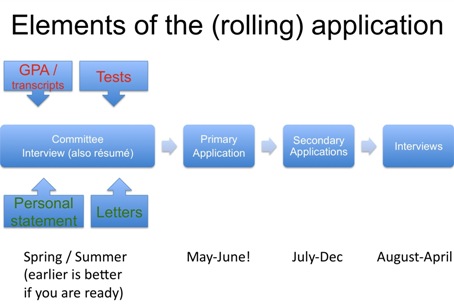What is the “right time” to apply?
Answer: June of the appropriate year.
What is the appropriate year?
Answer: When you are ready. Discuss with the HPP Director.
When will I be ready?
Answer: When you are certain that a particular health profession is what you want to do, when you will be a competitive applicant, and when a demanding educational program fits into your life.
Should I take a Bridge (Gap) year(s)?
Answer: The average age of people entering medical school is 24. Many medical/dental/vet school admissions highly value post-college life experiences. Approaches and strategies for pursuing a bridge year can be discussed with the HPP Director.
Is it worth pursing Rhodes, Churchill or Fulbright Scholarships before going to medical school?
Answer: Yes, these experiences are prestigious; however, it depends on timing and should be discussed with the HPP Director.
- You should apply in June of the year BEFORE you wish to matriculate (e.g. June 2015 for fall 2016). You should plan to be available for interviews from August to April (don’t be abroad).
Do schools value post-bacc research at the NIH or a year of service in the Americorps Health Corps?
Answer: Most definitely. Again, timing is key and how you convey the impacts of these experiences to your desire to serve in health care is critical.
Allopathic Medicine

Final Deadlines range between October and December
You could consider your HPP committee meeting to be timely if it is done by early June. Earlier meetings (March – April) are often preferred by students who do not need to wait for spring grades or letters of recommendation from recently started experiences. This is because committee letters are processed in a roughly first in, first out manner. Later meetings might also make sense in particular situations. Here is the national data on committee letter timing. Holding your committee meeting as late as the week of spring finals, or after grades are posted toward the end of May or even in early June (you should plan a strategy that optimizes this choice for you with Dr. D'Antonio) will not slow down your application process in a meaningful way. The details of the AMCAS application submission process are such that you do not need a committee letter to submit your primary application. Actually, there are four loosely related submissions that are required for full consideration of your application by medical schools:
1. You submit your primary application in early June (the system allows you to start work in May). As you prepare your primary application, you will produce a transcript request form and ONE letter request form with Dr. D'Antonio's name and contact information on it. The letter request form will either be for a committee letter packet, or if you choose to forgo a committee meeting (despite recommendations to the contrary), a letter packet.
2. You submit your transcript request form to the Hub (and to all other colleges attended) and ask them to hold it until spring grades are available (if applicable). The Hub is usually quite prompt.
3. You give your letter request form to the HPP office (a PDF version via email is fine). This form has a bar code and a unique identification number on it. When your committee letter packet (committee letter + all individual letters) is ready, we will upload it to AMCAS using the Virtual Evals system.
4. After you submit your primary to AMCAS, they will validate the information it contains. Then they will release it to medical schools. The earliest this could be (by AAMC policy) would be the last Friday in June. At that point, schools will begin to send you secondary applications. You should write these carefully, addressing your fit at each individual school (and you should do this efficiently). A good goal might be to submit one secondary application every 48 hours or to have them all done by the end of July or mid August at the latest.
Medical schools want to make decisions to interview based on three things: the validated primary application (requires all transcripts), the (committee) letter packet, and the school specific secondary application. Our goal for turnaround on committee letters after meetings is six weeks after the meeting is held, but at peak times, it can be slower. Regardless, if you have your committee meeting by early June, it is unlikely that the timing of the letter will result in a meaningful delay as June plus the first half of July will give you (and your committee!!!) six weeks of time.
You should also review more detailed information on committee interviews.
The AAMC has provided helpful recommendations on the timing of the application and admissions process (aka "traffic rules") for both applicants and admissions officers. Reading the information provided in the links for both applicants and admissions officers should help you to stay on track with regard to timing after interviewing.
Dental Medicine

Optometry
Osteopathic Medicine

Pharmacy
Podiatric Medicine
Public Health
Veterinary Medicine
Many colleges of veterinary medicine use the Veterinary Medical College Application Service (VMCAS). The VMCAS system typically goes live in early June and has a deadline for submission in early October. Some colleges of veterinary medicine begin reviewing applications as early as August, but others wait until after the October deadline to consider applicants. A veterinary medical school application must be on time, but early submission is unlikely to confer any real benefit.
Note that the Cummings School of Veterinary Medicine at Tufts University does not participate in VMCAS and has a November 1st deadline.